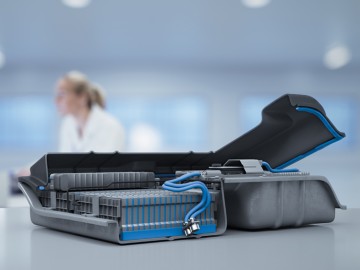
Solutions to a Hot Issue
Most experts agree: tomorrow’s cars will be electric. The automotive industry has set the development of electromobility at the top of its agenda. However, there are still obstacles to be overcome prior to mass production. One burning question is: How do you protect sensitive electronics in vehicles against overheating?
The electric motor, traction battery and power electronics in electric cars work with high electrical outputs and generate heat during operation. If they overheat, this can lead to the aging and premature failure of the components. To prevent this, the released heat must be rapidly and effectively dissipated.
For thermal management, silicones are the perfect material. They can efficiently dissipate heat – even from complicated shapes – and they maintain their properties for a long period of time over a broad range of temperatures (-50 °C to +180 °C, special grades up to +230 °C). They can also withstand mechanical stress, vibrations and temperature fluctuations and are therefore ideal for meeting the extreme demands in electric cars.
Thermal Management in Batteries

Electric vehicles predominantly use lithium-ion batteries (LIBs) as energy storage. These are usually installed below the passenger compartment and require an active thermal heat management. A thermally conductive gap filler is needed to provide thermal coupling between the battery modules and the heat-dissipation system. It must be aging resistant to prevent premature battery failure and must lend itself to rapid application to large surfaces.
With the SEMICOSIL® 96x TC series, WACKER has developed a range of thermally conductive gap fillers that are not only cost-effective and easy to process, but also offer safe functionality and high durability.
Thermal Management in Power Electronics

A further source of heat in electric vehicles are power electronics that transform and regulate the electric current. Inverters, for example, convert direct current into alternating current and vice versa, while voltage converters change the level of the voltage. Power modules components such as IGBTs (integrated gate bipolar transistors) can reach temperatures greater than 100 °C during operation. Overheating can damage the sensitive semiconductor structures and thus lead to aging and finally to failure of the components.
Such failures can be prevented by actively cooling the printed board and IGBT assembly. At operating temperatures above 150 °C, silicone-based TIMs are the materials of choice for thermal coupling because organic polymers would be unable to withstand the heat. Depending on the design, effective component cooling can be achieved with thermally conductive gap fillers, encapsulants and heat-sink pastes or adhesives. Products of choice are available under the WACKER brands SEMICOSIL® and ELASTOSIL®.
Thermal Management in Electric Motors

Even an electric motor generates heat during operation – despite a high degree of efficiency, which is generally over 90 percent (in comparison to 30 – 45 percent in combustion engines). For two reasons, efficient heat dissipation is necessary in electric motors as well: Firstly, the wire enamels coated onto the stator windings need to be protected against heat-induced aging. Second, permanent-magnet synchronous motors contain magnetic materials made from rare earth metals, which can lose their magnetization at temperatures above 130 °C. Also, the heat dissipated from the electric motor can be readily deployed elsewhere to heat the passenger compartment and the windshield.
Want to Know More about WACKER Silicones for e-Mobility Applications?
Learn more about how our solutions innovate the future of e-mobility.
Discover our Products